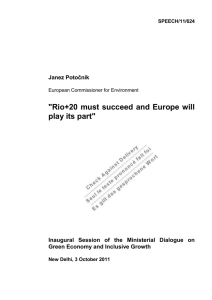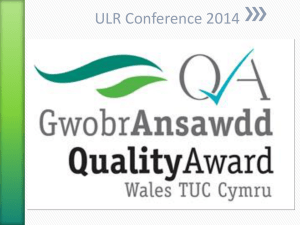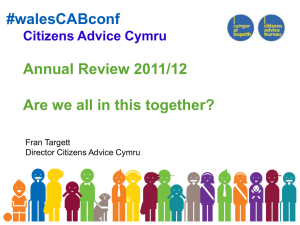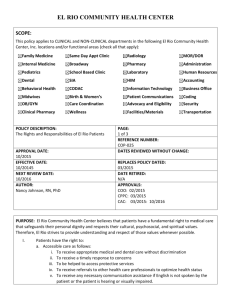Sustainable Development Goals – the new
advertisement
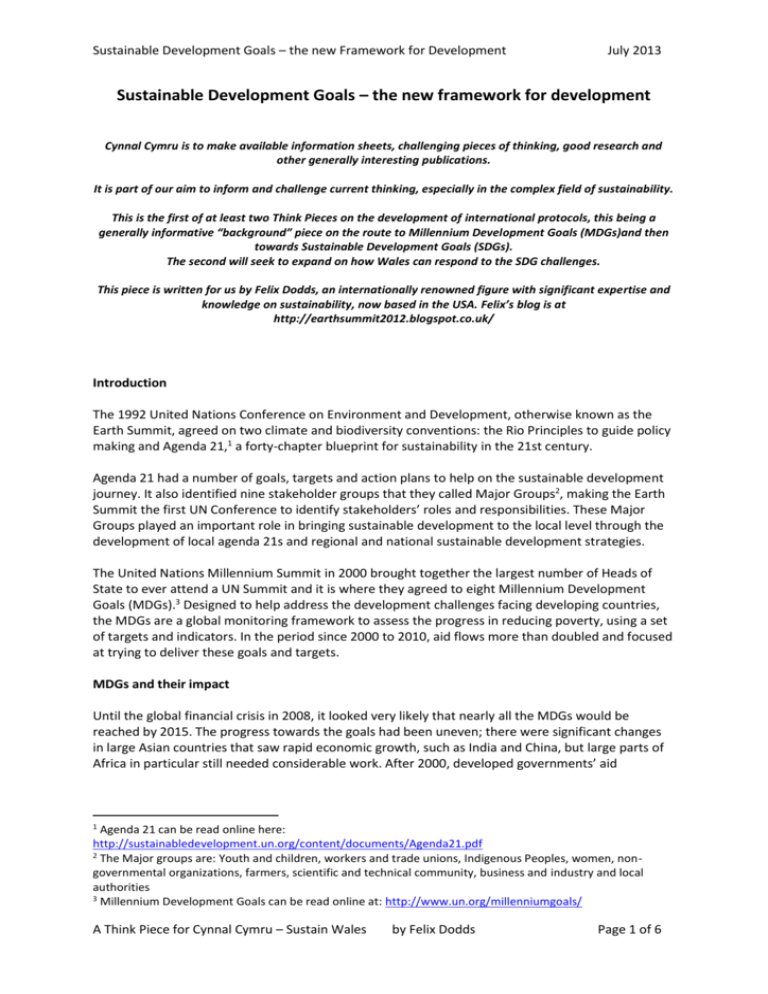
Sustainable Development Goals – the new Framework for Development July 2013 Sustainable Development Goals – the new framework for development Cynnal Cymru is to make available information sheets, challenging pieces of thinking, good research and other generally interesting publications. It is part of our aim to inform and challenge current thinking, especially in the complex field of sustainability. This is the first of at least two Think Pieces on the development of international protocols, this being a generally informative “background” piece on the route to Millennium Development Goals (MDGs)and then towards Sustainable Development Goals (SDGs). The second will seek to expand on how Wales can respond to the SDG challenges. This piece is written for us by Felix Dodds, an internationally renowned figure with significant expertise and knowledge on sustainability, now based in the USA. Felix’s blog is at http://earthsummit2012.blogspot.co.uk/ Introduction The 1992 United Nations Conference on Environment and Development, otherwise known as the Earth Summit, agreed on two climate and biodiversity conventions: the Rio Principles to guide policy making and Agenda 21,1 a forty-chapter blueprint for sustainability in the 21st century. Agenda 21 had a number of goals, targets and action plans to help on the sustainable development journey. It also identified nine stakeholder groups that they called Major Groups2, making the Earth Summit the first UN Conference to identify stakeholders’ roles and responsibilities. These Major Groups played an important role in bringing sustainable development to the local level through the development of local agenda 21s and regional and national sustainable development strategies. The United Nations Millennium Summit in 2000 brought together the largest number of Heads of State to ever attend a UN Summit and it is where they agreed to eight Millennium Development Goals (MDGs).3 Designed to help address the development challenges facing developing countries, the MDGs are a global monitoring framework to assess the progress in reducing poverty, using a set of targets and indicators. In the period since 2000 to 2010, aid flows more than doubled and focused at trying to deliver these goals and targets. MDGs and their impact Until the global financial crisis in 2008, it looked very likely that nearly all the MDGs would be reached by 2015. The progress towards the goals had been uneven; there were significant changes in large Asian countries that saw rapid economic growth, such as India and China, but large parts of Africa in particular still needed considerable work. After 2000, developed governments’ aid 1 Agenda 21 can be read online here: http://sustainabledevelopment.un.org/content/documents/Agenda21.pdf 2 The Major groups are: Youth and children, workers and trade unions, Indigenous Peoples, women, nongovernmental organizations, farmers, scientific and technical community, business and industry and local authorities 3 Millennium Development Goals can be read online at: http://www.un.org/millenniumgoals/ A Think Piece for Cynnal Cymru – Sustain Wales by Felix Dodds Page 1 of 6 Sustainable Development Goals – the new Framework for Development July 2013 departments focused a large proportion of their aid to deliver the goals. There is evidence aid was most effective in countries with strong policies and institutions4. The financial crisis (2008) saw many governments reduce their development aid and the Netherlands became the first country that had previously given aid above the UN target of 0.7 percent to fall below the target. On the other hand, the UK – with all-party support -- will reach the 0.7 percent UN aid target for the first time in 2013 having ring-fenced the aid budget.5 The overall assessment in 2012 was that: MDG1, on halving those in absolute poverty, had been reached. MDG2 on education parity of girls and boys has been reached at the primary level. MDG 7’s target on halving those without access to water was reached, although the sanitation target was not. MDG7’s target on slum dwellers was also reached eight years ahead of its target date of 2020. Many of the other targets are in danger of backward movement as we approach 20156. In preparation for the 2015 United Nations Summit to review progress and set new goals, the UN Secretary General set up a number of processes. These were: National consultations in over 100 countries – the European Union ran an online consultation; Eleven thematic consultations7 These would feed into a High Level Panel on post-2015, chaired by the UK Prime Minister and the Presidents of Liberia and Indonesia What about Rio+20? Rio+20 was painted by much of the media and some NGOs as a failure. It was not, and may go down as the turning point in securing sustainable development as the main organizing concept of the twenty first century. The process leading up to Rio had looked hopeless: the previous five years had seen the failure at two UN Commissions on Sustainable Development (CSD) in 2007 and 2011 and the failure at the Copenhagen climate meeting in 2009. But Rio+20, instead, put in place a new set of building blocks to move towards a more sustainable future. New Building Blocks The first building block was reform of the global institutions on environment and sustainable development. Over the last forty years for UNEP and over the last twenty years for the CSD, it had become clear that both were beyond their selling date. The UN Environment Programme was made into a UN universal body and the CSD was to be closed down and replaced by a High Level Political Forum (HLPF). The HLPF will meet every four years at Heads of State level. 4 UNDP Report: http://www.undp.org/content/dam/undp/library/Poverty%20Reduction/Inclusive%20development/Towards% 20Human%20Resilience/Towards_SustainingMDGProgress_Ch5.pdf 5 Budget speech: https://www.gov.uk/government/speeches/budget-2013-chancellors-statement 6 UN Press Release: http://www.un.org/millenniumgoals/pdf/Press%20Release%20MDG%20Report%202012.pdf 7 Eleven thematic consultations: Conflict and Fragility, Education, Environmental Sustainability, Governance, Growth and employment, Health, Hunger, food and nutrition security, Inequalities, Population Dynamics, Energy and Water. Available online at: http://www.un.org/en/development/desa/area-ofwork/post2015.shtml A Think Piece for Cynnal Cymru – Sustain Wales by Felix Dodds Page 2 of 6 Sustainable Development Goals – the new Framework for Development July 2013 Another very important building block that Rio+20 set in motion was an intergovernmental open working group (OWG) to develop sustainable development goals (SDG). These SDGs would be at the centre of any new goals agreed in 2015. Unlike the 2000 Millennium Summit where the goals only applied to developing countries, and the environment was an afterthought, these new goals would place due focus on the environment and would be universal – meaning ALL countries would have to address them and would be judged on their progress. The SDG OWG would produce its report for the United Nations General Assembly in September 2014. This would start a one-year process to agree on new goals and targets by September 2015. To finance these new goals, Rio+20 set up another intergovernmental process, an expert committee on financing sustainable development, to work parallel to the SDG OWG. The financing process would be undertaken parallel to the development of the goals instead of waiting until the new goals are agreed upon to ensure the funding is already in place. The world has measured gross in the past by the gross domestic product a country produces. Rio+20 also recognized the need for broader progress indicators to complement gross domestic product in order to better inform policy decisions. The conference agreed upon a ten-year programme on sustainable consumption and production, another important building block, to securing a more sustainable future. These building blocks were vital to help re-establish sustainable development as a credible concept. In addition, Rio+20 dealt with the green economy but progress was not as successful in this sector. This was the first time that the economy had been discussed in the sustainable development conferences since 1972, even though the 1972 UN Stockholm Environment Conference did have as an input the Club of Rome’s seminal report ‘Limits to Growth8’. Some developing countries were worried about the commodification of nature, so they blocked the conference making long-term green economy decisions. Rio+20, however, did see 50 companies and countries, including the UK, agreeing to have natural capital accounts published yearly. Concurrently to Rio+20 were a number of significant events and publications that will help shape our approach to a more sustainable future. One of the most important was the work of the Stockholm Resilience Centre to identify a set of nine planetary boundaries that we should not exceed. Three of which, climate, biodiversity and nitrogen cycle, we already have exceeded to the detriment of the health of the planet and its people9. This was supplemented by the work of Oxfam that suggested any planetary boundaries would also need to recognise a set of social foundations10 and that between these two was a safe and just operating space for humanity. To underpin the work on planetary boundaries, the global science community reorganized themselves into a new front called Future Earth11. The Rio+20 outcome document also recognized the increased inter-linkages between food security, energy security and water security – known as the Nexus. Over the last ten years it has become clearer that there are a number of key drivers that are going to impact on the availability of water, energy and food in the future. These include: growing urbanization, rising consumption rates in the emerging economies like India and China and population increase of 2 billion by 2050. If things continue this way: 8 Club of Rome’s Limits to Growth available online at: http://www.clubofrome.org/?p=326 Planetary boundaries available online at: http://www.stockholmresilience.org/planetary-boundaries 10 Oxfam Doughnut available online at: http://www.oxfam.org/en/grow/video/2012/introducing-doughnutsafe-and-just-space-humanity 11 Future Earth available online: http://www.icsu.org/future-earth 9 A Think Piece for Cynnal Cymru – Sustain Wales by Felix Dodds Page 3 of 6 Sustainable Development Goals – the new Framework for Development July 2013 Agriculture will have to produce 70 percent more food by 2050 Primary energy needs will increase by 50 percent by 2035 Demand for water will exceed global availability by 40 percent in 203012 High-level Panel of Eminent Persons on the global development agenda beyond 2015 Set up in 2011 by the UN Secretary General, the High Level Panel was chaired by the UK Prime Minister and the Presidents of Liberia and Indonesia. The panel met five times and conducted strong outreach for input to over 100 national consultations on 11 issue-based themes, as well as additional meetings with stakeholders throughout. The panel made its report on the 30 May, building strongly on the previous panel set up by the UN Secretary General for the Rio+20 conference, the Global Sustainability Panel. That panel had made a number of suggestions that were developed further by this current panel. One of these was that all companies with a turnover of over $100 million should by 2030 be producing sustainability reports. This was a campaign spearheaded for Rio+20 by AVIVA from industry and Stakeholder Forum, an international NGO, both UK domiciled. An overview of what goals are being suggested There are a number of lists of possible sustainable development goals that have already been suggested. In Annex 2 there is a list of four sets from: UN Secretary Generals High Level Panel Stockholm Resilience Centre Sustainable Development Solutions Network UN DPI NGO Conference (2011) What is emerging is a set of core thematic areas where goals most likely are: Poverty Education Health Water Energy Food and Agriculture Employment It is unclear if gender or governance will have separate goals or will be cross-cutting or both. Beyond this core group, we will see considerable pressure for additional ones on sustainable consumption and production, sustainable cities, and possibly one on oceans and seas. It is also unclear how areas that have conventions, such as climate change and biodiversity will be dealt with. Biodiversity already has a set of targets and indicators agreed in 2010. For further information, please see the United Nation’s SDG site: http://sustainabledevelopment.un.org/index.php?menu=1300 Attached are two Annexes, one to help explain terms, the other to identify certain bodies and their areas of competence. 12 Understanding the Nexus: http://www.water-energy-food.org/en/whats_the_nexus/background.html A Think Piece for Cynnal Cymru – Sustain Wales by Felix Dodds Page 4 of 6 Sustainable Development Goals – the new Framework for Development July 2013 Annex 1 Term How it is used in this Report Goal Expresses an ambitious, but specific, commitment. Always starts with a verb/action. Targets Quantified sub-components that will contribute in a major way to achievement of goal. Should be an outcome variable. Indicators Precise metric from identified databases to assess if target is being met (often multiple indicators are used). A Think Piece for Cynnal Cymru – Sustain Wales by Felix Dodds Page 5 of 6 Sustainable Development Goals – the new Framework for Development July 2013 Annex 2 Stockholm Resilience Centre UN High Level Panel on post-2015 Governance for Sustainable Societies Ensure Good Governance and Effective Institutions Universal Clean Energy Secure Sustainable Energy Sustainable Food Security Ensure Food Security and Good Nutrition Sustainable Water Security Achieve Universal Access to Water and Sanitation Healthy and Productive Ecosystems Manage Natural Resource Assets Sustainably Thriving lives and Livelihoods Create Jobs, Sustainable Livelihoods, and Equitable Growth End Poverty Empower Girls and Women and Achieve Gender Equality Provide Quality Education and Lifelong Learning Ensure Healthy lives Sustainable Development Solutions Network Transform Governance for Sustainable Development Curb Human-Induced Climate Change and Ensure Sustainable Energy Improve Agriculture Systems and Raise Rural Prosperity UN DPI NGO Conference 2011 Governance covering access to information, participation and environmental justice Climate Sustainability and Clean Energy Sustainable agriculture Universal availability of an acceptable quantity and quality of water – right to water and sanitation Secure Ecosystem Services and Biodiversity, and Ensure Good Management of Water and Other Natural Resources Biodiversity and healthy forests Sustainable livelihoods, youth and education Ending Extreme Poverty Ensure Effective Learning for all Children and Youth for Life and Livelihood Achieving Health and Wellbeing at all Ages Ensure Stable and Peaceful Societies Create a Global Enabling Environment and Catalyze Long-Term Finance Achieve development within Planetary Boundaries Empower Inclusive, Productive, and Resilient Cities Green cities Sustainable consumption and production Healthy seas and oceans A Think Piece for Cynnal Cymru – Sustain Wales by Felix Dodds Page 6 of 6
